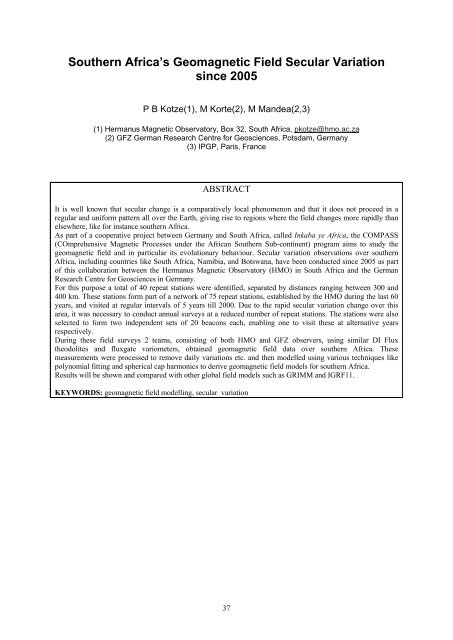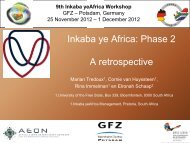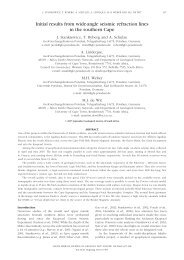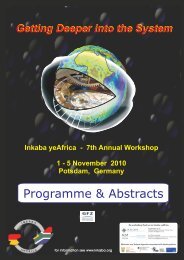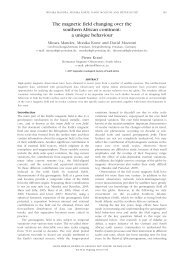South Africa - Inkaba.org
South Africa - Inkaba.org
South Africa - Inkaba.org
Create successful ePaper yourself
Turn your PDF publications into a flip-book with our unique Google optimized e-Paper software.
<strong>South</strong>ern <strong>Africa</strong>’s Geomagnetic Field Secular Variation<br />
since 2005<br />
P B Kotze(1), M Korte(2), M Mandea(2,3)<br />
(1) Hermanus Magnetic Observatory, Box 32, <strong>South</strong> <strong>Africa</strong>, pkotze@hmo.ac.za<br />
(2) GFZ German Research Centre for Geosciences, Potsdam, Germany<br />
(3) IPGP, Paris, France<br />
ABSTRACT<br />
It is well known that secular change is a comparatively local phenomenon and that it does not proceed in a<br />
regular and uniform pattern all over the Earth, giving rise to regions where the field changes more rapidly than<br />
elsewhere, like for instance southern <strong>Africa</strong>.<br />
As part of a cooperative project between Germany and <strong>South</strong> <strong>Africa</strong>, called <strong>Inkaba</strong> ye <strong>Africa</strong>, the COMPASS<br />
(COmprehensive Magnetic Processes under the <strong>Africa</strong>n <strong>South</strong>ern Sub-continent) program aims to study the<br />
geomagnetic field and in particular its evolutionary behaviour. Secular variation observations over southern<br />
<strong>Africa</strong>, including countries like <strong>South</strong> <strong>Africa</strong>, Namibia, and Botswana, have been conducted since 2005 as part<br />
of this collaboration between the Hermanus Magnetic Observatory (HMO) in <strong>South</strong> <strong>Africa</strong> and the German<br />
Research Centre for Geosciences in Germany.<br />
For this purpose a total of 40 repeat stations were identified, separated by distances ranging between 300 and<br />
400 km. These stations form part of a network of 75 repeat stations, established by the HMO during the last 60<br />
years, and visited at regular intervals of 5 years till 2000. Due to the rapid secular variation change over this<br />
area, it was necessary to conduct annual surveys at a reduced number of repeat stations. The stations were also<br />
selected to form two independent sets of 20 beacons each, enabling one to visit these at alternative years<br />
respectively.<br />
During these field surveys 2 teams, consisting of both HMO and GFZ observers, using similar DI Flux<br />
theodolites and fluxgate variometers, obtained geomagnetic field data over southern <strong>Africa</strong>. These<br />
measurements were processed to remove daily variations etc. and then modelled using various techniques like<br />
polynomial fitting and spherical cap harmonics to derive geomagnetic field models for southern <strong>Africa</strong>.<br />
Results will be shown and compared with other global field models such as GRIMM and IGRF11.<br />
KEYWORDS: geomagnetic field modelling, secular variation<br />
37


